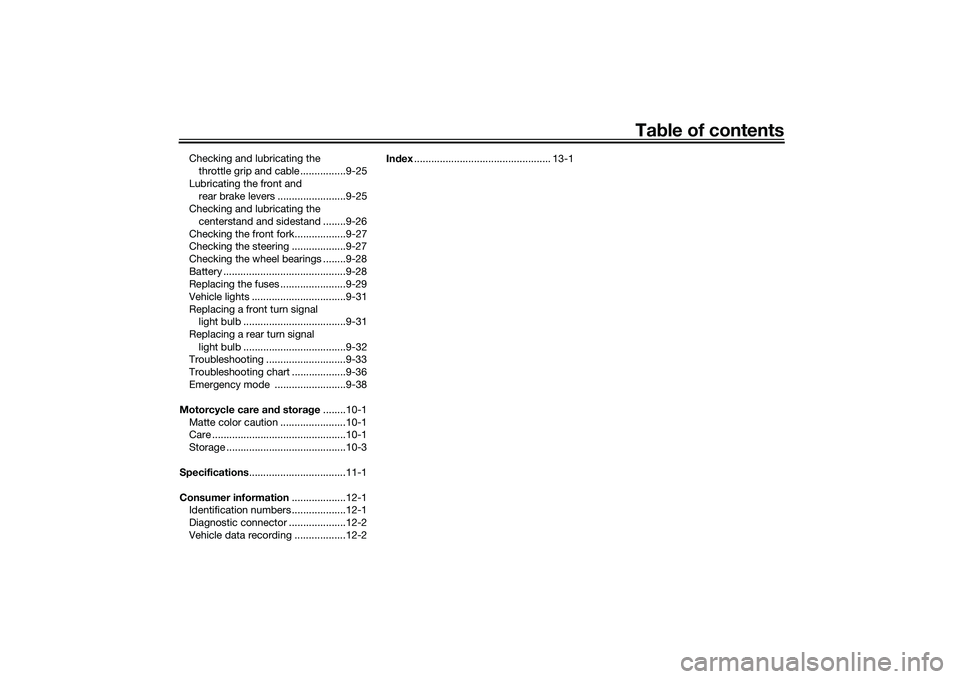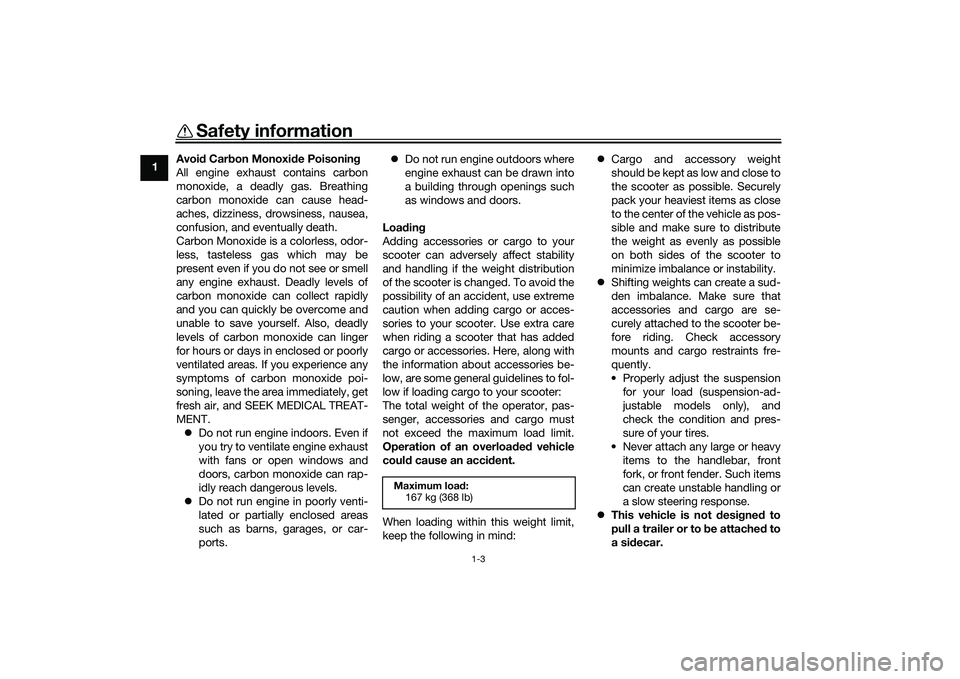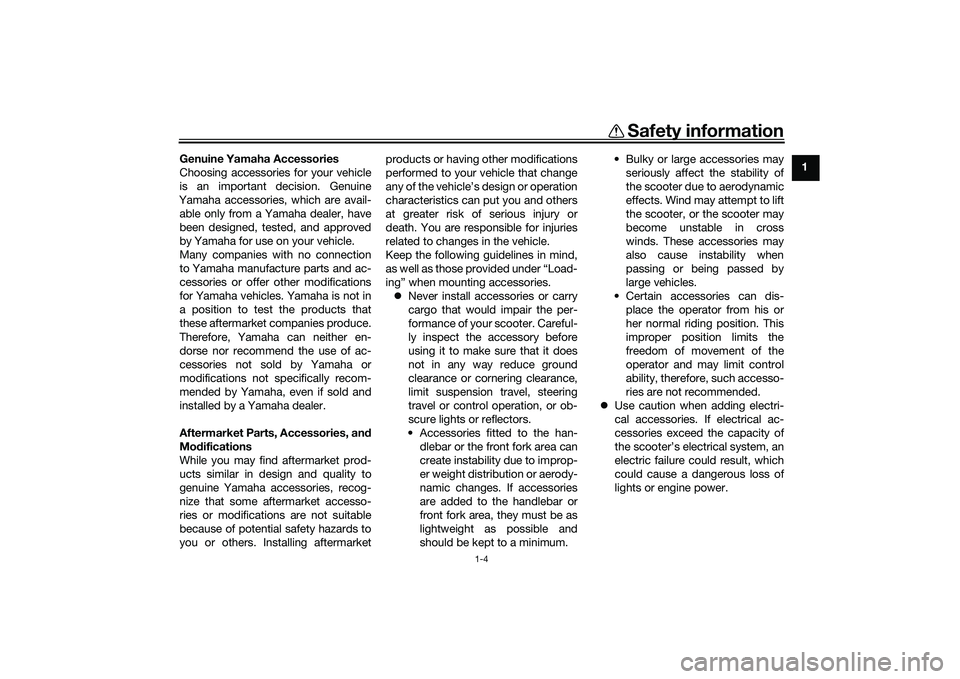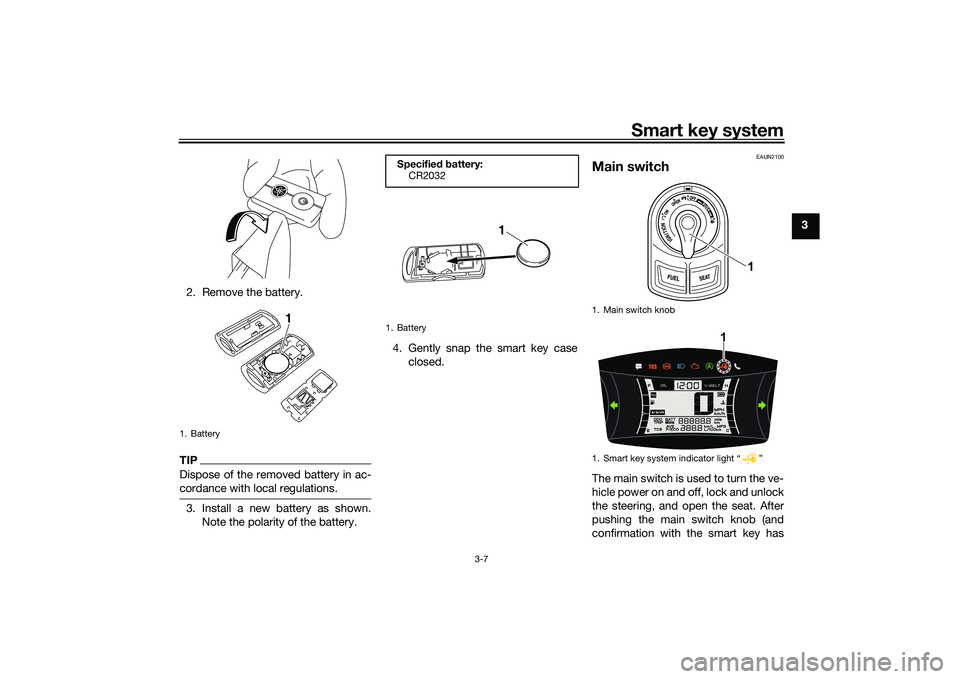steering YAMAHA NMAX 155 2021 Owners Manual
[x] Cancel search | Manufacturer: YAMAHA, Model Year: 2021, Model line: NMAX 155, Model: YAMAHA NMAX 155 2021Pages: 114, PDF Size: 10.93 MB
Page 9 of 114

Table of contents
Checking and lubricating the
throttle grip and cable ................9-25
Lubricating the front and rear brake levers ........................9-25
Checking and lubricating the
centerstand and sidestand ........9-26
Checking the front fork..................9-27
Checking the steering ...................9-27
Checking the wheel bearings ........9-28
Battery ...........................................9-28
Replacing the fuses .......................9-29
Vehicle lights .................................9-31
Replacing a front turn signal light bulb ....................................9-31
Replacing a rear turn signal light bulb ....................................9-32
Troubleshooting ............................9-33
Troubleshooting chart ...................9-36
Emergency mode .........................9-38
Motorcycle care an d stora ge ........10-1
Matte color caution .......................10-1
Care ...............................................10-1
Storage ..........................................10-3
Specifications ..................................11-1
Consumer information ...................12-1
Identification numbers ...................12-1
Diagnostic connector ....................12-2
Vehicle data recording ..................12-2 In
dex ................................................ 13-1
UBBDE0E0.book Page 2 Wednesday, June 2, 2021 2:57 PM
Page 12 of 114

Safety information
1-3
1Avoi
d Car bon Monoxi de Poisonin g
All engine exhaust contains carbon
monoxide, a deadly gas. Breathing
carbon monoxide can cause head-
aches, dizziness, drowsiness, nausea,
confusion, and eventually death.
Carbon Monoxide is a colorless, odor-
less, tasteless gas which may be
present even if you do not see or smell
any engine exhaust. Deadly levels of
carbon monoxide can collect rapidly
and you can quickly be overcome and
unable to save yourself. Also, deadly
levels of carbon monoxide can linger
for hours or days in enclosed or poorly
ventilated areas. If you experience any
symptoms of carbon monoxide poi-
soning, leave the area immediately, get
fresh air, and SEEK MEDICAL TREAT-
MENT. Do not run engine indoors. Even if
you try to ventilate engine exhaust
with fans or open windows and
doors, carbon monoxide can rap-
idly reach dangerous levels.
Do not run engine in poorly venti-
lated or partially enclosed areas
such as barns, garages, or car-
ports.
Do not run engine outdoors where
engine exhaust can be drawn into
a building through openings such
as windows and doors.
Loa din g
Adding accessories or cargo to your
scooter can adversely affect stability
and handling if the weight distribution
of the scooter is changed. To avoid the
possibility of an accident, use extreme
caution when adding cargo or acces-
sories to your scooter. Use extra care
when riding a scooter that has added
cargo or accessories. Here, along with
the information about accessories be-
low, are some general guidelines to fol-
low if loading cargo to your scooter:
The total weight of the operator, pas-
senger, accessories and cargo must
not exceed the maximum load limit.
Operation of an overloa ded vehicle
coul d cause an acci dent.
When loading within this weight limit,
keep the following in mind:
Cargo and accessory weight
should be kept as low and close to
the scooter as possible. Securely
pack your heaviest items as close
to the center of the vehicle as pos-
sible and make sure to distribute
the weight as evenly as possible
on both sides of the scooter to
minimize imbalance or instability.
Shifting weights can create a sud-
den imbalance. Make sure that
accessories and cargo are se-
curely attached to the scooter be-
fore riding. Check accessory
mounts and cargo restraints fre-
quently.
• Properly adjust the suspension for your load (suspension-ad-
justable models only), and
check the condition and pres-
sure of your tires.
• Never attach any large or heavy items to the handlebar, front
fork, or front fender. Such items
can create unstable handling or
a slow steering response.
This vehicle is not desi gne d to
pull a trailer or to be attached to
a si decar.
Maximum loa d:
167 kg (368 lb)
UBBDE0E0.book Page 3 Wednesday, June 2, 2021 2:57 PM
Page 13 of 114

Safety information
1-4
1
Genuine Yamaha Accessories
Choosing accessories for your vehicle
is an important decision. Genuine
Yamaha accessories, which are avail- able only from a Yamaha dealer, have
been designed, tested, and approved
by Yamaha for use on your vehicle.
Many companies with no connection
to Yamaha manufacture parts and ac-
cessories or offer other modifications
for Yamaha vehicles. Yamaha is not in
a position to test the products that
these aftermarket companies produce.
Therefore, Yamaha can neither en-
dorse nor recommend the use of ac-
cessories not sold by Yamaha or
modifications not specifically recom-
mended by Yamaha, even if sold and
installed by a Yamaha dealer.
Aftermarket Parts, Accessories, an d
Mo difications
While you may find aftermarket prod-
ucts similar in design and quality to
genuine Yamaha accessories, recog-
nize that some aftermarket accesso-
ries or modifications are not suitable
because of potential safety hazards to
you or others. Installing aftermarket products or having other modifications
performed to your vehicle that change
any of the vehicle’s design or operation
characteristics can put you and others
at greater risk of serious injury or
death. You are responsible for injuries
related to changes in the vehicle.
Keep the following guidelines in mind,
as well as those provided under “Load-
ing” when mounting accessories.
Never install accessories or carry
cargo that would impair the per-
formance of your scooter. Careful-
ly inspect the accessory before
using it to make sure that it does
not in any way reduce ground
clearance or cornering clearance,
limit suspension travel, steering
travel or control operation, or ob-
scure lights or reflectors.
• Accessories fitted to the han- dlebar or the front fork area can
create instability due to improp-
er weight distribution or aerody-
namic changes. If accessories
are added to the handlebar or
front fork area, they must be as
lightweight as possible and
should be kept to a minimum. • Bulky or large accessories may
seriously affect the stability of
the scooter due to aerodynamic
effects. Wind may attempt to lift
the scooter, or the scooter may
become unstable in cross
winds. These accessories may
also cause instability when
passing or being passed by
large vehicles.
• Certain accessories can dis- place the operator from his or
her normal riding position. This
improper position limits the
freedom of movement of the
operator and may limit control
ability, therefore, such accesso-
ries are not recommended.
Use caution when adding electri-
cal accessories. If electrical ac-
cessories exceed the capacity of
the scooter’s electrical system, an
electric failure could result, which
could cause a dangerous loss of
lights or engine power.
UBBDE0E0.book Page 4 Wednesday, June 2, 2021 2:57 PM
Page 25 of 114

Smart key system
3-7
3
2. Remove the battery.
TIPDispose of the removed battery in ac-
cordance with local regulations.3. Install a new battery as shown. Note the polarity of the battery. 4. Gently snap the smart key case
closed.
EAUN2100
Main switchThe main switch is used to turn the ve-
hicle power on and off, lock and unlock
the steering, and open the seat. After
pushing the main switch knob (and
confirmation with the smart key has
1. Battery
1
Specified b attery:
CR2032
1. Battery
1
1. Main switch knob
1. Smart key system indicator light Ž
1
1
UBBDE0E0.book Page 7 Wednesday, June 2, 2021 2:57 PM
Page 28 of 114

Smart key system
3-10
3Open position remin
der
To prevent you from accidentally leav-
ing the vehicle unlocked by walking
away with the main switch still in the
“OPEN” position, the smart key system
beeper will sound under the following
conditions. When the main switch has been in
the open position for 3 minutes
If the smart key is turned off while
the main switch is in the open po-
sition
If you walk out of range of the
smart key system with the main
switch in the open position
If the beeper sounds after 3 minutes,
turn the main switch to “OFF” or “ ”. If
the beeper sounds because the smart
key was turned off or moved out of
range, turn the smart key on and walk
back into range.
TIP The beeper will turn off after 1
minute.
EAU76521
“ ” (lock)
The steering is locked and all electrical
systems are off.
To lock the steering1. Turn the handlebar all the way to
the left.
2. With the smart key turned on and within operating range, push the
main switch knob.
3. While the smart key system indi- cator light is on, push and turn the
main switch to “ ”.
TIPIf the steering will not lock, try turning
the handlebar back to the right slightly.To unlock the steering1. With the smart key turned on andwithin operating range, push the
main switch knob.
2. While the smart key system indi- cator light is on, push and turn the
main switch to the desired posi-
tion.
1. Push.
2. Turn.1 2
1. Push.
2. Turn.12
UBBDE0E0.book Page 10 Wednesday, June 2, 2021 2:57 PM
Page 90 of 114

Periodic maintenance an d a djustment
9-27
9
EAU23273
Checkin g the front forkThe condition and operation of the
front fork must be checked as follows
at the intervals specified in the periodic
maintenance and lubrication chart.
To check the con dition
Check the inner tubes for scratches,
damage and excessive oil leakage.
To check the operation 1. Place the vehicle on a level sur- face and hold it in an upright posi-
tion. WARNING! To avoi d injury,
securely support the vehicle so
there is no dan ger of it fallin g
over.
[EWA10752]
2. While applying the front brake, push down hard on the handle-
bars several times to check if the
front fork compresses and re-
bounds smoothly.
NOTICE
ECA10591
If any d amage is foun d or the front
fork does not operate smoothly,
have a Yamaha dealer check or re-
pair it.
EAU45512
Checkin g the steerin gWorn or loose steering bearings may
cause danger. Therefore, the operation
of the steering must be checked as fol-
lows at the intervals specified in the
periodic maintenance and lubrication
chart.
1. Place the vehicle on the center- stand. WARNING! To avoi d inju-
ry, securely support the vehicle
so there is no dan ger of it fallin g
over.
[EWA10752]
2. Hold the lower ends of the front fork legs and try to move them for-
ward and backward. If any free
play can be felt, have a Yamaha
dealer check or repair the steer-
ing.
UBBDE0E0.book Page 27 Wednesday, June 2, 2021 2:57 PM
Page 113 of 114

Index
13-2
13
Speedometer .......................................... 6-4
Starting off .............................................. 8-2
Starting the engine ................................. 8-2
Start switch........................................... 6-10
Steering, checking ................................ 9-27
Stop and Start System ........................... 4-1
Stop and Start System indicator light .... 6-2
Stop and Start System operation ........... 4-1
Stop and Start System switch .............. 6-11
Stop and Start System
troubleshooting .................................. 9-34
Storage ................................................. 10-3
Storage compartments......................... 6-19TThrottle grip and cable, checking and lubricating .................... 9-25
Throttle grip free play, checking ........... 9-19
Tires ...................................................... 9-19
Tool kit .................................................... 9-1
Traction control system ........................ 6-13
Traction control system indicator light ... 6-2
Troubleshooting.................................... 9-33
Troubleshooting chart .......................... 9-36
Turn signal indicator lights ..................... 6-1
Turn signal light bulb (front), replacing............................................. 9-31
Turn signal light bulb (rear), replacing............................................. 9-32
Turn signal switch................................. 6-10VValve clearance .................................... 9-19
V-belt, checking.................................... 9-24
Vehicle identification number ............... 12-1
Vehicle lights ........................................ 9-31 VVA indicator.......................................... 6-5
WWheel bearings, checking .................... 9-28
Wheels ................................................. 9-21YYamalube ............................................. 9-13
UBBDE0E0.book Page 2 Wednesday, June 2, 2021 2:57 PM